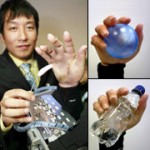Archive for Июнь, 2007
Разработана нежная кисть для роботов
- Тип контента: Новостная статья
- Номер документа: 2274
- Название документа: Разработана нежная кисть для роботов
- Номер (DOI, IBSN, Патент): Не заполнено
- Изобретатель/автор: Не заполнено
- Правопреемник/учебное заведение: Не заполнено
- Дата публикации документа: 2007-06-27
- Страна опубликовавшая документ: Россия
- Язык документа: Русский
- Наименование изделия: Не заполнено
- Источник: http://www.membrana.ru/particle/11647
- Вложения: Не заполнено
- Аналитик: Ридна Украина)))
 Японская компания Squse представила новую руку для роботов, основанную на искусственных мышцах. Достоинством своей разработки фирма называет аккуратность обращения руки с такими хрупкими вещами, как стекло или сырые куриные яйца.
Японская компания Squse представила новую руку для роботов, основанную на искусственных мышцах. Достоинством своей разработки фирма называет аккуратность обращения руки с такими хрупкими вещами, как стекло или сырые куриные яйца.
Категория: Кисти рук | Нет комментариев »
Design of an Exoskeleton Mechanism for the Shoulder Joint
- Тип контента: Научная статья
- Номер документа: 6076
- Название документа: Design of an Exoskeleton Mechanism for the Shoulder Joint
- Номер (DOI, IBSN, Патент): Не заполнено
- Изобретатель/автор: Georgios Patsianis, Evangelos Papadopoulos
- Правопреемник/учебное заведение: Department of Mechanical Engineering, National Technical University of Athens Athens, Greece
- Дата публикации документа: 2007-06-21
- Страна опубликовавшая документ: Греция
- Язык документа: Английский
- Наименование изделия: Не заполнено
- Источник: 12th IFToMM World Congress, Besançon (France)
- Вложения: Да
- Аналитик: Глаголева Елена
 This paper focuses on the design of a 2-DOF exo-skeletal mechanism for the lateral and frontal abduction of the human upper limb. Major consideration was placed on the location of the center of rotation of the humerous with respect to the scapula.An experimen-tal procedure for the determination of the kinematics of the shoulder girdle area using a CMM machine is described. The motion of the center of rotation of the shoulder is obtained using a Geneva mechanism. Kine-matical analysis of the proposed hybrid mechanism is discussed and a validation study is presented. A 3D CAD model of the mechanism is presented and a FEM analysis illustrates the stability and durability of the portable mechanism. It is expected that the mechanism under development will help people suffering from muscle atrophy or to accelerate injured people recovery.
This paper focuses on the design of a 2-DOF exo-skeletal mechanism for the lateral and frontal abduction of the human upper limb. Major consideration was placed on the location of the center of rotation of the humerous with respect to the scapula.An experimen-tal procedure for the determination of the kinematics of the shoulder girdle area using a CMM machine is described. The motion of the center of rotation of the shoulder is obtained using a Geneva mechanism. Kine-matical analysis of the proposed hybrid mechanism is discussed and a validation study is presented. A 3D CAD model of the mechanism is presented and a FEM analysis illustrates the stability and durability of the portable mechanism. It is expected that the mechanism under development will help people suffering from muscle atrophy or to accelerate injured people recovery.
Категория: Научные статьи | Нет комментариев »
Complementary Limb Motion Estimation based on Interjoint Coordination: Experimental Evaluation
- Тип контента: Научная статья
- Номер документа: 7053
- Название документа: Complementary Limb Motion Estimation based on Interjoint Coordination: Experimental Evaluation
- Номер (DOI, IBSN, Патент): Не заполнено
- Изобретатель/автор: Heike Vallery, Ralf Ekkelenkamp, Martin Buss, Herman van der Kooij
- Правопреемник/учебное заведение: Faculty of Mechanical Engineering, University of Twente, Institute of Automatic Control Engineering, Technische Universitat Miinchen
- Дата публикации документа: 2007-06-15
- Страна опубликовавшая документ: Германия
- Язык документа: Английский
- Наименование изделия: Не заполнено
- Источник: Proceedings of the 2007 IEEE 10th International Conference o
- Вложения: Да
- Аналитик: Глаголева Елена
 For motor rehabilitation of hemiplegic patients by means of motorized orthoses, as well as in intelligent prosthetics, a major challenge is the coordination of healthy and robotically assisted limbs. The new method of Complementary Limb Motion Estimation (CLME) analyzes depen-dencies among human Degrees of Freedom (DoFs) in healthy subjects. Based on this knowledge, adequate motion for inoperable DoFs in patients is estimated on-line from sound limb motion. Thus, the intention of a partially paralyzed person or an amputee can be deduced from residual body motion, in order to coordina-tely actuate or supervise the impaired limbs. The aim is to increase the dominance of the patient and to reduce the robot to an assistive device. In continuity of priorly published evaluation by comuter simula-tions, this paper presents a first experimental proof of concept of CLME with healthy subjects. The results of these preliminary tests affirm the suitability of the algorithm for cooperative human-robot interaction.
For motor rehabilitation of hemiplegic patients by means of motorized orthoses, as well as in intelligent prosthetics, a major challenge is the coordination of healthy and robotically assisted limbs. The new method of Complementary Limb Motion Estimation (CLME) analyzes depen-dencies among human Degrees of Freedom (DoFs) in healthy subjects. Based on this knowledge, adequate motion for inoperable DoFs in patients is estimated on-line from sound limb motion. Thus, the intention of a partially paralyzed person or an amputee can be deduced from residual body motion, in order to coordina-tely actuate or supervise the impaired limbs. The aim is to increase the dominance of the patient and to reduce the robot to an assistive device. In continuity of priorly published evaluation by comuter simula-tions, this paper presents a first experimental proof of concept of CLME with healthy subjects. The results of these preliminary tests affirm the suitability of the algorithm for cooperative human-robot interaction.
Категория: Научные статьи | Нет комментариев »
Managing regeneration in RoboteQ controllers
- Тип контента: Научная статья
- Номер документа: 8195
- Название документа: Managing regeneration in RoboteQ controllers
- Номер (DOI, IBSN, Патент): Не заполнено
- Изобретатель/автор: Не заполнено
- Правопреемник/учебное заведение: Не заполнено
- Дата публикации документа: 2007-06-14
- Страна опубликовавшая документ: Не заполнено
- Язык документа: Английский
- Наименование изделия: Не заполнено
- Источник: RoboteQ
- Вложения: Да
- Аналитик: Глаголева Елена
 Electrical motors are reversible machines; they can function as motors or as generators. A motor receives electrical power from a battery and transforms it in torque developing a Counter Electromotive Force CEMF, which opposes the battery. A generator receives mechanical power from a mechanical actuator and transforms it in electrical power developing a Counter Torque, which opposes the actuator. A motor behaves as motor and as generator at the same time. In fact while a motor is ‘motoring’, that is doing mechanical work, it generates CEMF acting as generator, although the CEMF is lower than the battery voltage so the motor acts as a load and absorbs current. In certain situations the CEMF may overcome the battery, in which case the generator component becomes dominant; the motor acts as a generator inverting the direction of its current and forcing it into the battery. The typical situation is the one of a heavy vehicle rolling on a sharp downhill slope and forcing the motor to turn fast enough that the CEMF becomes larger than the battery voltage. As soon as the motor overcomes the battery it inverts the current direction and starts feeding current into the battery, while developing a counter torque that acts as a brake. This phase is called regeneration (recharging of the battery).
Electrical motors are reversible machines; they can function as motors or as generators. A motor receives electrical power from a battery and transforms it in torque developing a Counter Electromotive Force CEMF, which opposes the battery. A generator receives mechanical power from a mechanical actuator and transforms it in electrical power developing a Counter Torque, which opposes the actuator. A motor behaves as motor and as generator at the same time. In fact while a motor is ‘motoring’, that is doing mechanical work, it generates CEMF acting as generator, although the CEMF is lower than the battery voltage so the motor acts as a load and absorbs current. In certain situations the CEMF may overcome the battery, in which case the generator component becomes dominant; the motor acts as a generator inverting the direction of its current and forcing it into the battery. The typical situation is the one of a heavy vehicle rolling on a sharp downhill slope and forcing the motor to turn fast enough that the CEMF becomes larger than the battery voltage. As soon as the motor overcomes the battery it inverts the current direction and starts feeding current into the battery, while developing a counter torque that acts as a brake. This phase is called regeneration (recharging of the battery).
Категория: Научные статьи | Нет комментариев »
Статистика
Категорий: 179
Статей всего: 2,003
По типу:
Видео: 36
Выдержка с форума: 1
Контактные данные: 12
Научная статья: 1388
Не заполнено: 5
Новостная статья: 317
Обзор технологии: 42
Патент: 219
Тех.подробности: 34
Тип: 1
Комментариев: 9,470
Изображений: 3,005
Подробней...
ТОР 10 аналитиков
-
Глаголева Елена - 591
Дмитрий Соловьев - 459
Helix - 218
Ридна Украина))) - 85
Наталья Черкасова - 81
max-orduan - 29
Елена Токай - 15
Роман Михайлов - 9
Мансур Жигануров - 4
Дуванова Татьяна - 3
Календарь
Авторизация
Ошибка в тексте?
Выдели её мышкой!
И нажми Ctrl+Enter